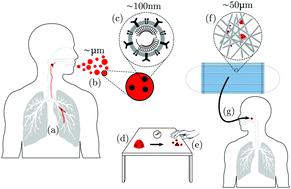当前位置:
X-MOL 学术
›
Soft Matter
›
论文详情
Our official English website, www.x-mol.net, welcomes your
feedback! (Note: you will need to create a separate account there.)
Soft matter science and the COVID-19 pandemic.
Soft Matter ( IF 2.9 ) Pub Date : 2020-09-02 , DOI: 10.1039/d0sm01223h Wilson C K Poon 1 , Aidan T Brown 1 , Susana O L Direito 1 , Daniel J M Hodgson 1 , Lucas Le Nagard 1 , Alex Lips 1 , Cait E MacPhee 1 , Davide Marenduzzo 1 , John R Royer 1 , Andreia F Silva 1 , Job H J Thijssen 1 , Simon Titmuss 1
Soft Matter ( IF 2.9 ) Pub Date : 2020-09-02 , DOI: 10.1039/d0sm01223h Wilson C K Poon 1 , Aidan T Brown 1 , Susana O L Direito 1 , Daniel J M Hodgson 1 , Lucas Le Nagard 1 , Alex Lips 1 , Cait E MacPhee 1 , Davide Marenduzzo 1 , John R Royer 1 , Andreia F Silva 1 , Job H J Thijssen 1 , Simon Titmuss 1
Affiliation

|
Much of the science underpinning the global response to the COVID-19 pandemic lies in the soft matter domain. Coronaviruses are composite particles with a core of nucleic acids complexed to proteins surrounded by a protein-studded lipid bilayer shell. A dominant route for transmission is via air-borne aerosols and droplets. Viral interaction with polymeric body fluids, particularly mucus, and cell membranes controls their infectivity, while their interaction with skin and artificial surfaces underpins cleaning and disinfection and the efficacy of masks and other personal protective equipment. The global response to COVID-19 has highlighted gaps in the soft matter knowledge base. We survey these gaps, especially as pertaining to the transmission of the disease, and suggest questions that can (and need to) be tackled, both in response to COVID-19 and to better prepare for future viral pandemics.
中文翻译:

软物质科学和COVID-19大流行。
对COVID-19大流行做出全球反应的许多科学基础都在软物质领域。冠状病毒是复合颗粒,具有与蛋白质复合的核酸核心,蛋白质核心被蛋白质镶嵌的脂质双层壳包围。传输的主要途径是通过空气传播的气溶胶和飞沫。病毒与聚合体液(特别是粘液)和细胞膜的相互作用控制了它们的感染性,而它们与皮肤和人造表面的相互作用则增强了清洁和消毒以及口罩和其他个人防护设备的功效。全球对COVID-19的回应突显了软物质知识库中的空白。我们调查了这些差距,特别是与疾病传播有关的差距,并提出了可以(和需要)解决的问题,以应对COVID-19,并为未来的病毒性大流行做好更好的准备。
更新日期:2020-09-23
中文翻译:

软物质科学和COVID-19大流行。
对COVID-19大流行做出全球反应的许多科学基础都在软物质领域。冠状病毒是复合颗粒,具有与蛋白质复合的核酸核心,蛋白质核心被蛋白质镶嵌的脂质双层壳包围。传输的主要途径是通过空气传播的气溶胶和飞沫。病毒与聚合体液(特别是粘液)和细胞膜的相互作用控制了它们的感染性,而它们与皮肤和人造表面的相互作用则增强了清洁和消毒以及口罩和其他个人防护设备的功效。全球对COVID-19的回应突显了软物质知识库中的空白。我们调查了这些差距,特别是与疾病传播有关的差距,并提出了可以(和需要)解决的问题,以应对COVID-19,并为未来的病毒性大流行做好更好的准备。











































 京公网安备 11010802027423号
京公网安备 11010802027423号